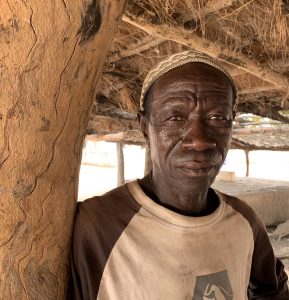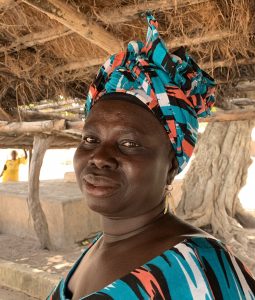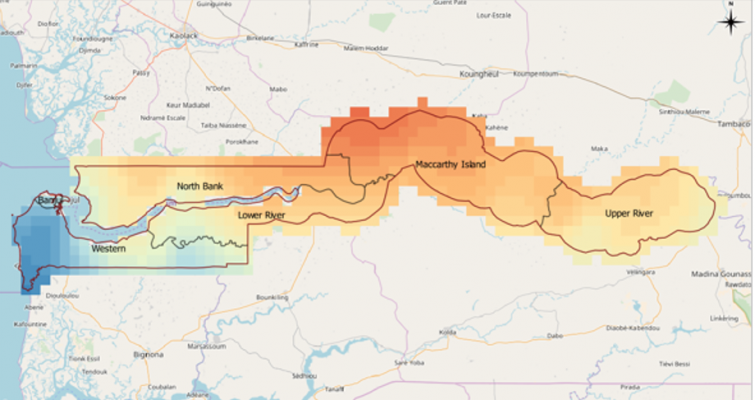Originally published by World Agroforestry
Burnt by fire, trees thicken bark: but a Green Climate Fund project encourages them to fruit instead.
Batelling Village lies in the Lower River Region of The Gambia, on the south side of the mighty river that runs the length of the country, and next to Kiang West National Park.

On a recent visit, the village seemed tranquil. Men chatted under a vast fig. Sheep ate tree leaves. A boy served tea.
The calm, however, hid suffering. Among the many challenges are raging bush fires, monkeys and baboons converging on homes in search of food; and a collapse of wild fruit, nuts, edible leaves, pods and other comestibles from the forest.
‘Previously we had the fruits of ‘duto’, ‘kaba’ and ‘neto’; now wild fruits are almost extinct,’ said villager Mamodou Sanyang, using the Mandinka names for Cordyla africana, Saba senegalensis and Parkia biglobosa.
In The Gambia, the climate crisis has lessened annual rainfall, made it more erratic, and raised temperatures by 1.3–2 °C. The former park ranger said droughts had started five years ago and bush fires were now more frequent.
‘Drought came because of shortage of trees. When I was young, we could go five years without a fire.’

Photo: World Agroforestry/Cathy Watson
Mother of nine, Sustayring Jang, lamented the disappearance of ‘tonboron’ (Ziziphus mauritiana), a tangy fruit that when you ‘peel and powder, you can turn into a drink’. She also said, ‘millet harvests are diminishing’ and raids by primates are now routine.
But Mamodou and Jang believe solutions are emerging under a project they call ‘EbA’. Funded by the Green Climate Fund, with the UN Environment Programme as the GCF-accredited implementing agency, its full name is Large-scale Ecosystem-based Adaptation Project in the Gambia River Basin.
Led by the Government, targets include restoring over 10,000 hectares of degraded community forests and farmlands in different regions of The Gambia.
‘We are going to enrich the forest in the park with edible wild plants,’ says Lalisa Duguma, a senior researcher running World Agroforestry’s component of the project. ‘This will reduce human–wildlife conflict. The forest around here is very degraded and monkeys are missing what to eat. It has become a fight for survival for them too.’
Ecosystem-based adaptation is an approach that strengthens ecosystem services to reduce the impact of climate change, protect communities from extreme weather and provide ecological benefits, such as clean water and food. The aim of the EbA project is to move The Gambia towards a ‘climate-resilient, natural resource-based economy’.
Forests are a vital ecosystem to strengthen and never more so than in this West African state, which, ‘100 years ago’, wrote forester Jato Sillah in 2002, ‘was almost entirely covered by dense forest that was rich in wildlife’.
Today, just 43% of The Gambia is forested (excluding mangroves) and 78% of this is tree and shrub savannah. Buffalo, giraffe, elephant and lion are locally extinct.
With partners, the World Agroforestry team identified four ways to restore forests: enrichment planting, assisted natural regeneration, reforestation and afforestation.
‘Assisted natural regeneration is among the most cost effective,’ says a project report. ‘It requires little human intervention except management of interference. It aims to facilitate the successional recovery of degraded areas by minimizing or eliminating the impediments to vegetation recovery by, for example, reducing grazing intensity or fire damage.’
After deep consultations with the village members and the wildlife department, this option was selected as the most suitable and fire was identified as the major impediment.

By solving the problem of fire, the project potentially solves the raiding monkeys and loss of wild food, upon which 48% of rural Gambians rely, according to the baseline survey. And, in the future, the resurgent forest might even bring more rain.
The villagers are quietly euphoric. The project paid them to cut a firebreak. And in a major victory, the fire that used to scare them every dry season did not cross the firebreak.
‘Previously we used to be threatened but this year fire was contained,’ says Jang. ‘Due to lack of fire, there will be more fruit,’ she adds confidently.
‘EbA is really good,’ says Mamodou. ‘It has created a fire belt to prevent fire intrusion and one of the benefits of not having fire is that animals will have an opportunity to eat the fruit and that’s a relief for them.’
As we drive to the fire break, Duguma and Gambian researcher Alagie Bah become excited. On the left, the ground is burnt. But the firebreak prevented the fire from leaping the track and into the national park to our right. We are joined by Lamin Sanyang, who lives locally.
‘This is a fire-prone zone and previously it was very difficult for us to stop fire. We would try to beat it out with branches but it normally burned the park. When we created this 10-metre fire strip, however, the fire had nothing to feed upon and finished here,’ he says, pointing to a line on the ground. ‘The park did not burn. Now we will get natural regeneration of trees.’
This is inspiring hope. But how does fire suppress fruit? In the forest, Duguma explains, his finger on the bark of a Pterocarpus erinaceus. He says the deep fissures are a defence that the tree puts up against fire.
‘Trees invest in growing protective structures to protect the phloem,’ says the Ethiopian scientist, referring to the vascular tissue through which sugar from photosynthesis travels from leaves to the rest of the tree.
‘The plant allocates its resources to this thick bark to survive. But by suppressing fire pressure, we reduce stress. These trees will not be compelled to produce this armour as heavily as they do now. It will not be necessary. Available resources can be diverted to production of more leaves, flowers and fruits.’
If the fire break is tactic number 1, tactic number 2 is clearing vegetation from around key species because inevitably fire will sometimes penetrate the forest and the ‘project cannot protect every tree,’ says Duguma.
‘With the community we identified the top ten species they want to conserve and cleared a two-metre radius around about 370,000 trees across 1400 hectares. This tackles the fuel load on the soil surface. Within the same space, we also clear the tall elephant grass that connects the ground to tree canopy to prevent vertical expansion of flames engulfing it.’
Pointing to numerous young saplings, he adds, ‘clearing the ground also protects young seedlings around mother trees’.
This innovation to protect forests and key species within them is just one activity under ‘EbA’. World Agroforestry, UN Environment and Government partners have also generated maps, tools, forest inventories, community plans and restoration guides.
At USD 20.5 million, ‘this is the single-largest natural resource development project in the history of this country and it’s funded by the Green Climate Fund,’ said Lamin Dibba, The Gambia’s Minister of Environment, Climate Change and Natural Resources at its launch in 2018.
This is a project to watch, set in one of the world’s most climate-fragile countries.











